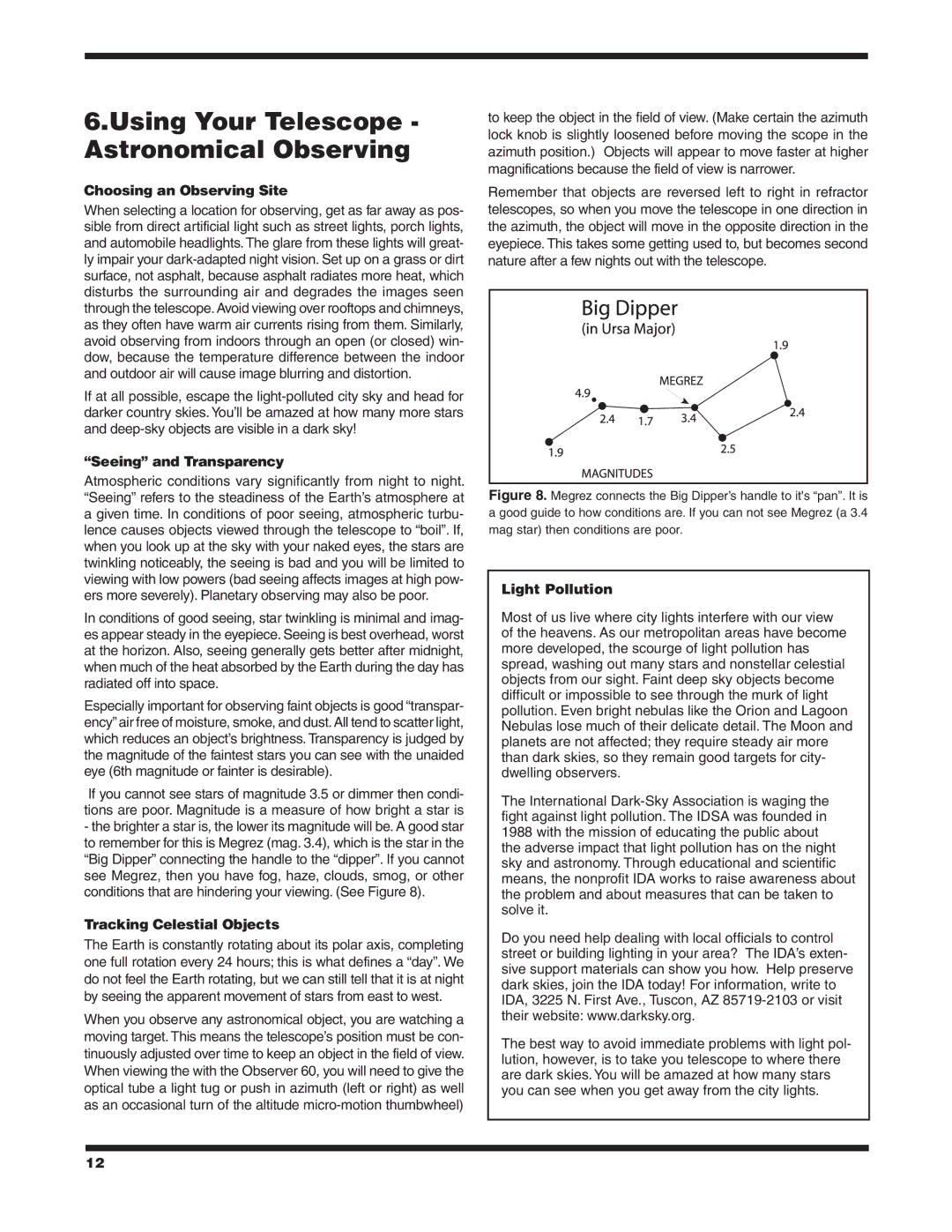6.Using Your Telescope - Astronomical Observing
Choosing an Observing Site
When selecting a location for observing, get as far away as pos- sible from direct artificial light such as street lights, porch lights, and automobile headlights. The glare from these lights will great- ly impair your dark-adapted night vision. Set up on a grass or dirt surface, not asphalt, because asphalt radiates more heat, which disturbs the surrounding air and degrades the images seen through the telescope. Avoid viewing over rooftops and chimneys, as they often have warm air currents rising from them. Similarly, avoid observing from indoors through an open (or closed) win- dow, because the temperature difference between the indoor and outdoor air will cause image blurring and distortion.
If at all possible, escape the light-polluted city sky and head for darker country skies. You’ll be amazed at how many more stars and deep-sky objects are visible in a dark sky!
“Seeing” and Transparency
Atmospheric conditions vary significantly from night to night. “Seeing” refers to the steadiness of the Earth’s atmosphere at a given time. In conditions of poor seeing, atmospheric turbu- lence causes objects viewed through the telescope to “boil”. If, when you look up at the sky with your naked eyes, the stars are twinkling noticeably, the seeing is bad and you will be limited to viewing with low powers (bad seeing affects images at high pow- ers more severely). Planetary observing may also be poor.
In conditions of good seeing, star twinkling is minimal and imag- es appear steady in the eyepiece. Seeing is best overhead, worst at the horizon. Also, seeing generally gets better after midnight, when much of the heat absorbed by the Earth during the day has radiated off into space.
Especially important for observing faint objects is good “transpar- ency” air free of moisture, smoke, and dust.All tend to scatter light, which reduces an object’s brightness. Transparency is judged by the magnitude of the faintest stars you can see with the unaided eye (6th magnitude or fainter is desirable).
If you cannot see stars of magnitude 3.5 or dimmer then condi- tions are poor. Magnitude is a measure of how bright a star is
-the brighter a star is, the lower its magnitude will be. A good star to remember for this is Megrez (mag. 3.4), which is the star in the “Big Dipper” connecting the handle to the “dipper”. If you cannot see Megrez, then you have fog, haze, clouds, smog, or other conditions that are hindering your viewing. (See Figure 8).
Tracking Celestial Objects
The Earth is constantly rotating about its polar axis, completing one full rotation every 24 hours; this is what defines a “day”. We do not feel the Earth rotating, but we can still tell that it is at night by seeing the apparent movement of stars from east to west.
When you observe any astronomical object, you are watching a moving target. This means the telescope’s position must be con- tinuously adjusted over time to keep an object in the field of view. When viewing the with the Observer 60, you will need to give the optical tube a light tug or push in azimuth (left or right) as well as an occasional turn of the altitude micro-motion thumbwheel)
to keep the object in the field of view. (Make certain the azimuth lock knob is slightly loosened before moving the scope in the azimuth position.) Objects will appear to move faster at higher magnifications because the field of view is narrower.
Remember that objects are reversed left to right in refractor telescopes, so when you move the telescope in one direction in the azimuth, the object will move in the opposite direction in the eyepiece. This takes some getting used to, but becomes second nature after a few nights out with the telescope.
Figure 8. Megrez connects the Big Dipper’s handle to it's “pan”. It is a good guide to how conditions are. If you can not see Megrez (a 3.4 mag star) then conditions are poor.
Light Pollution
Most of us live where city lights interfere with our view of the heavens. As our metropolitan areas have become more developed, the scourge of light pollution has spread, washing out many stars and nonstellar celestial objects from our sight. Faint deep sky objects become difficult or impossible to see through the murk of light pollution. Even bright nebulas like the Orion and Lagoon Nebulas lose much of their delicate detail. The Moon and planets are not affected; they require steady air more than dark skies, so they remain good targets for city- dwelling observers.
The International Dark-Sky Association is waging the fight against light pollution. The IDSA was founded in 1988 with the mission of educating the public about the adverse impact that light pollution has on the night sky and astronomy. Through educational and scientific means, the nonprofit IDA works to raise awareness about the problem and about measures that can be taken to solve it.
Do you need help dealing with local officials to control street or building lighting in your area? The IDA’s exten- sive support materials can show you how. Help preserve dark skies, join the IDA today! For information, write to IDA, 3225 N. First Ave., Tuscon, AZ 85719-2103 or visit their website: www.darksky.org.
The best way to avoid immediate problems with light pol- lution, however, is to take you telescope to where there are dark skies. You will be amazed at how many stars you can see when you get away from the city lights.

